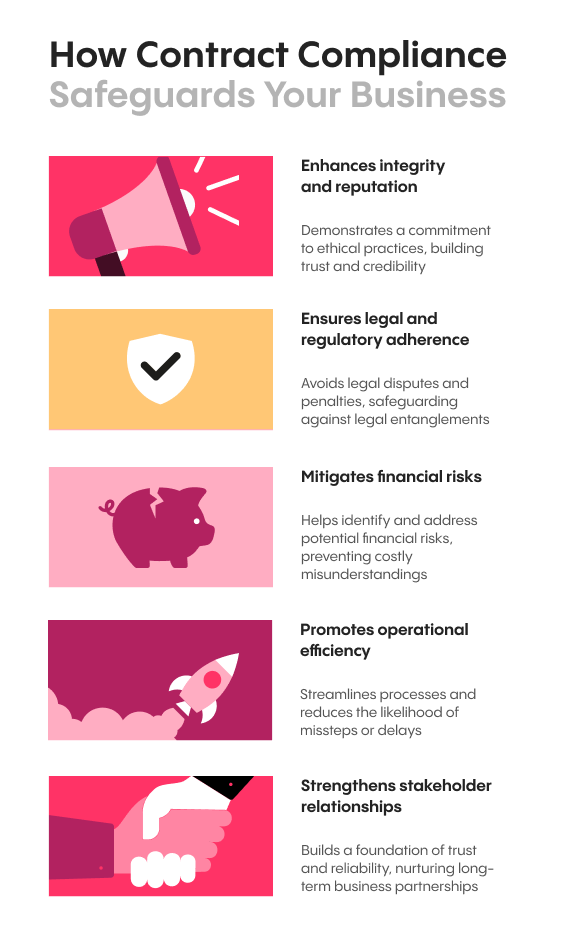Contract Compliance: The Ultimate Guide
Table of contents
- What is contract compliance?
- Why is contract compliance important?
- Examples of contract compliance and non-compliance
- Contract compliance challenges
- Risks of poor contract compliance
- What is contract compliance management?
- Best practices for contract compliance
- Conclusion: Compliance is a journey, not a destination
Your company’s relationships depend on your reputation for contract compliance. Whether you’re launching a new project or managing a long-term partnership, compliance keeps your company trustworthy.
In this detailed guide, we’ll dive into the world of contractual compliance — a critical priority that often gets overlooked in the hustle of day-to-day operations. Let’s get started with a straight-to-the-point definition.
What is contract compliance?
Contract compliance is the practice of making sure all parties involved in a business agreement adhere strictly to the terms set out in that contract, and with all relevant laws. It means making sure that every contract clause, stipulation, and contractual obligation outlined in an agreement is fulfilled as agreed upon.
This involves a continuous process of monitoring, management — and, when necessary, enforcement — to ensure that every term of the contract is being met. You can think of contract compliance as the glue that holds the relationship together, making sure all parties live up to their commitments and all projects progress as intended.
But compliance is far more than just a legal formality. It helps businesses avoid disputes, minimize contract risks, and maintain strong, trust-based relationships with partners and stakeholders. The idea is to create a transparent, accountable environment where every contract serves its purpose.
Why is contract compliance important?
Contract compliance is important because it protects your business against financial and reputational risks, by making sure you’re complying with all contract terms and applicable regulations.

Here’s how contract compliance safeguards your business:
- Enhances integrity and reputation: Adherence to contract terms demonstrates a commitment to ethical practices, building trust and credibility with clients, partners, and regulators.
- Ensures legal and regulatory adherence: By complying with the terms of contracts, businesses can avoid legal disputes and penalties, ensuring smooth operations and safeguarding against unnecessary legal entanglements.
- Mitigates financial risks: Proper contract compliance helps in identifying and addressing potential financial risks early on, preventing costly breaches or misunderstandings that could impact the bottom line.
- Promotes operational efficiency: Managing contracts effectively helps streamline many processes, and also reduces the likelihood of missteps or delays — leading to more efficient operations.
- Strengthens stakeholder relationships: Compliance builds a foundation of trust and reliability, which is crucial for sustaining and nurturing long-term business partnerships.
In all these ways, contract compliance helps your business operate more smoothly, maintain a strong reputation, and build lasting, trust-based relationships.
Examples of contract compliance and non-compliance
Let’s take a look at some examples of use cases where compliance comes into play in various industries. We’ll break down each scenario, examining the cause and outcome.
Below are four examples of contract compliance and non-compliance in various industries.
1. Tech industry (compliance)
- Scenario: A tech company signs a contract with a software developer to create a customized application within six months. The company diligently adheres to the agreed payment schedule and project milestones.
- Outcome: The project is completed on time, leading to a successful product launch. The tech company benefits from the timely delivery, gaining a competitive edge and boosting its market reputation. The strong adherence to contract terms fosters a lasting and trustworthy relationship with the developer.
2. Healthcare sector (non-compliance)
- Scenario: A healthcare provider enters into a contract with a vendor for medical equipment but the vendor fails to comply with the maintenance schedule outlined in the agreement.
- Outcome: The equipment malfunctions due to poor maintenance, causing delays in patient care, as well as intense regulatory scrutiny. The healthcare provider faces legal penalties, a tarnished reputation, and financial losses from both the equipment failure and the ensuing lawsuits. So they, in turn, sue the vendor for damages.
3. Manufacturing industry (compliance)
- Scenario: A manufacturing firm agrees to supply products to a retailer, with strict quality and delivery timelines specified in the contract. The manufacturer meticulously follows the contract terms, ensuring quality control and timely deliveries.
- Outcome: The retailer receives high-quality products on time, leading to increased sales and customer satisfaction. The manufacturer’s compliance bolsters the relationship with the retailer, securing future contracts and enhancing its industry standing.
4. Financial services industry (non-compliance)
- Scenario: A financial services company ignores a clause in a contract with a software provider that requires regular data security audits.
- Outcome: A data breach occurs, compromising customer information. The company faces regulatory fines, a loss of customer trust, and significant financial and reputational damage. The overlooked contract clause exacerbates the situation, leading to prolonged legal battles.
As you can see from these examples, diligent contractual compliance can result in stronger relationships and business success — while non-compliance can result in financial losses and even legal problems.
Contract compliance challenges
Addressing contract compliance challenges effectively is key to safeguarding your business’s relationships. So let’s take a closer look at some reasons why non-compliance can occur.
Below are four common hurdles in contract compliance, and ways to overcome them:
1. Inconsistent contract terms
- The challenge: Contracts, especially with multiple parties or across different projects, can sometimes contain inconsistent terms, leading to confusion and potential non-compliance.
- How to address it: Standardize contract clauses where possible, and use contract management software to track and align terms across all agreements. Regular reviews and updates to contracts can also ensure consistency.
2. Lack of clarity in obligations
- The challenge: Ambiguity in contract terms can lead to misunderstandings about the obligations of each party.
- How to address it: Clearly define all terms and obligations in the contract. Engage legal experts to review contracts for clarity and comprehensiveness. Training your team to understand contract specifics can also mitigate this issue.
3. Evolving legal and regulatory landscapes
- The challenge: Keeping up with changes in laws and regulations that affect contract terms can be daunting, leading to unintentional non-compliance.
- How to address it: Stay informed about legal and regulatory changes. Implement a system for regularly updating contracts to reflect these changes. Consider consulting with legal experts to ensure ongoing compliance.
4. Technological evolution
- The challenge: The increasing role of technology in business can complicate contract compliance, especially with regards to data security and privacy.
- How to address it: Leverage technology to your advantage by using contract management software for better oversight and compliance. Keep your IT team involved in contract processes to address any tech-specific compliance issues.
By proactively addressing these challenges, your business can maintain a strong contract compliance posture, helping to keep your operations running smoothly.
Risks of poor contract compliance
Neglecting contract compliance can expose your business to a range of risks — and understanding these risks will help you mitigate them in proactive ways.
Below are four common risks of poor contract compliance:
1. Legal and regulatory penalties
- The risk: Failing to comply with contract terms can lead to legal disputes, lawsuits, and regulatory penalties. This can result from breaches of contract, non-adherence to industry regulations, or failing to meet agreed-upon standards.
- How to prevent it: Ensure a thorough understanding and adherence to all contract terms. Regularly review contracts for compliance with current laws and industry standards. Seek legal advice to navigate complex contracts and regulations.
2. Financial losses
- The risk: Non-compliance can result in significant financial losses. These can stem from fines, legal costs, compensation for breaches, or lost business opportunities.
- How to prevent it: Implement proactive monitoring and management of contract terms. Develop a system to identify and address potential compliance issues early, reducing the likelihood of financial repercussions.
3. Damage to business reputation
- The risk: Your business’s reputation can suffer if it gains a reputation for poor contract compliance. This can lead to a loss of trust among clients, partners, and the broader market.
- How to prevent it: Foster a culture of transparency and ethical practices. Ensure consistent adherence to contract terms and openly communicate any challenges or changes with stakeholders.
4. Operational disruptions
- The risk: Inadequate contract compliance can lead to operational inefficiencies and disruptions. This can affect the smooth running of business processes, impacting service delivery and client satisfaction.
- How to prevent it: Regularly review and optimize contract administration processes. Train staff on the importance of contract compliance and its impact on operations.
By recognizing these risks and taking preventative measures as outlined above, your business can maintain a strong compliance framework, protecting you against many negative consequences of non-compliance.
What is contract compliance management?
Contract compliance management is the systematic approach to ensuring that all parties involved in a contract adhere to the terms and conditions outlined within it, throughout the entire lifecycle of the contract.
Overview of contract compliance management
This process involves the regular review and enforcement of contract terms, ensuring that both your business and your partners or suppliers are fulfilling their contractual duties.
It includes identifying potential risks of non-compliance and implementing strategies to mitigate these risks.
The significance of contract compliance management lies in its ability to enhance operational efficiency, minimize legal risks, and maintain positive business relationships.
The contract compliance process
The actual nuts-and-bolts maintenance of contractual compliance isn’t just a one-time process, but a continuous cycle in which you regularly review and optimize your adherence to contract terms.
The contract compliance process typically involves five key steps:
- Contract creation: Developing clear, unambiguous contracts that align with legal standards and business objectives.
- Review and approval: Thoroughly reviewing contracts before they are finalized and approved, ensuring that all terms are fair, clear, and enforceable.
- Ongoing monitoring: Regularly monitoring contract performance against the agreed terms, identifying any deviations or potential issues.
- Reporting and analysis: Keeping detailed records of compliance status and analyzing contract performance with contract management reporting tools to identify areas for improvement.
- Renewal or termination: Making informed decisions about contract renewal or termination based on compliance history and business needs.
The role of technology and automation
Technology plays a crucial role in contract compliance management. Contract management software can automate many aspects of the process, from tracking deadlines and obligations to flagging potential areas of non-compliance.
Automation ensures greater accuracy, efficiency, and consistency in managing contracts, allowing for real-time monitoring and quicker responses to compliance issues.
The importance of continuous monitoring and updates
The business landscape is always evolving, so contract compliance management also involves continuously updating and revising contracts to reflect changes in law, business practices, and market conditions.
That means contract compliance is a proactive, ongoing process that plays a central role in protecting your company’s interests, while keeping you on good terms with your partners, vendors and customers.
Best practices for contract compliance
Keeping your business in compliance with your contracts requires daily attention to a core set of best practices.
Below are six best practices to help maintain consistent compliance:
1. Establish clear contract terms.
Use clear, precise language and avoid ambiguity in your contracts. Be sure that all parties have a mutual understanding of the terms. Involve legal experts in drafting and reviewing contracts to ensure they are comprehensive and enforceable.
2. Perform regular compliance audits.
Conduct periodic audits to review and assess the level of compliance with contract terms. Use these audits to identify any discrepancies or areas of non-compliance and take corrective actions promptly.
3. Implement training and awareness programs.
Educate your team about the importance of contract compliance and their role in it. Regular training ensures everyone understands the terms of contracts and the consequences of non-compliance. Foster a culture where compliance is valued and understood as a critical part of business operations.
4. Leverage contract management software.
Use advanced contract management software to track compliance, deadlines, and obligations. This technology can automate reminders, generate compliance reports, and flag potential issues. Make sure the software is regularly updated and used effectively by the team.
5. Build a culture of compliance.
Promote a business culture that prioritizes and respects contractual obligations. This includes leadership setting a tone of ethical conduct and responsibility. Encourage open communication about compliance issues and ensure there is a clear process for addressing any concerns.
6. Document and update compliance procedures.
Maintain detailed records of compliance efforts, including audits, training sessions, and any actions taken to rectify non-compliance. Regularly update your compliance procedures to reflect changes in laws, regulations, and business practices.
By implementing these best practices, your business can not only avoid the pitfalls of non-compliance, but can strengthen its operational foundation, enhance its reputation, and build stronger, more reliable relationships.
Conclusion: Compliance is a journey, not a destination
As we’ve seen, contract compliance is not just a legal requirement, but a strategic imperative. When you adopt best practices for contractual compliance, and follow them on an ongoing basis, you’ll be able to mitigate risks while building strong relationships.
As you put these practices into place, keep in mind that effective contract compliance is a journey, not a destination. So it’s smart to build a culture of consistent attention and adaptation today, to meet the compliance challenges your business will face tomorrow.




